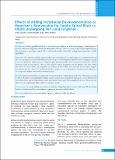Please use this identifier to cite or link to this item:
https://hdl.handle.net/20.500.14356/1594Full metadata record
| DC Field | Value | Language |
|---|---|---|
| dc.contributor.author | Gautam, Binod | - |
| dc.contributor.author | Lama, Sushila Moktan | - |
| dc.contributor.author | Sharma, Mona | - |
| dc.date.accessioned | 2023-05-16T07:30:06Z | - |
| dc.date.available | 2023-05-16T07:30:06Z | - |
| dc.date.issued | 2018 | - |
| dc.identifier.citation | GautamB., LamaS. M., & SharmaM. (2018). Effects of Adding Intrathecal Dexmedetomidine to Hyperbaric Bupivacaine for Saddle Spinal Block in Adults Undergoing Peri-anal Surgeries. Journal of Nepal Health Research Council, 16(1), 43-48. https://doi.org/10.33314/jnhrc.v16i1.1146 | en_US |
| dc.identifier.issn | Print ISSN: 1727-5482; Online ISSN: 1999-6217 | - |
| dc.identifier.uri | http://103.69.126.140:8080/handle/20.500.14356/1594 | - |
| dc.description | Original Article | en_US |
| dc.description.abstract | Abstract Background: Saddle spinal block is the first choice anesthetic technique for adults undergoing peri-anal surgeries. It prevents unnecessary high levels of analgesia and sympathetic block. However, it may not provide prolonged analgesia. This study aims to investigate analgesic effects of dexmedetomidine when added to hyperbaric bupivacaine in saddle spinal block. Methods: Fifty otherwise healthy adults scheduled for uncomplicated peri-anal surgery were randomly allocated into two equal groups in this double-blinded study. Group A received hyperbaric bupivacaine five milligrams; group B received hyperbaric bupivacaine five milligrams plus dexmedetomidine five micrograms intrathecally. Patients remained seated for ten minutes. Time to first analgesic request by patients was the primary end point. Onset and extent of sensory block, and, magnitude and duration of motor block were assessed. Post-operative analgesic consumption and side effects were studied for 24 hours. Student’s t-test for quantitative variables and Chi-square test for categorical variables were used for statistical analysis. Results: Patients in group B had a significantly prolonged duration of analgesia (group B, 501 ± 306 minutes; group A, 284 ± 58 minutes) and significantly reduced analgesic requirement than patients in group A. Sensory block in first sacral dermatome appeared significantly earlier in group B. Peak sensory block, magnitude of motor block, and side effects were not significantly different between groups A and B. Conclusions: Dexmedetomidine as an intrathecal adjuvant to hyperbaric bupivacaine in saddle spinal block prolongs duration of analgesia and decreases analgesic requirement with no added side effects. | en_US |
| dc.language.iso | en_US | en_US |
| dc.publisher | Nepal Health Research Council | en_US |
| dc.relation.ispartofseries | Jan - Mar 2018;1146 | - |
| dc.subject | Bupivacaine | en_US |
| dc.subject | Dexmedetomidine | en_US |
| dc.subject | Intrathecal adjuvant | en_US |
| dc.subject | Saddle spinal block | en_US |
| dc.title | Effects of Adding Intrathecal Dexmedetomidine to Hyperbaric Bupivacaine for Saddle Spinal Block in Adults Undergoing Peri-anal Surgeries | en_US |
| dc.type | Journal Article | en_US |
| local.journal.category | Original Article | - |
| Appears in Collections: | Vol. 16 No. 1 Issue 38 Jan-Mar 2018 | |
Files in This Item:
| File | Description | Size | Format | |
|---|---|---|---|---|
| 1146-Manuscript-3896-3-10-20180314.pdf | Full text Article | 271.66 kB | Adobe PDF |  View/Open |
Items in DSpace are protected by copyright, with all rights reserved, unless otherwise indicated.
